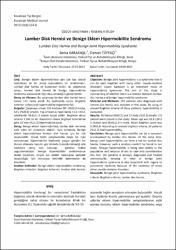| dc.contributor.author | Karakaşlı, Sema | |
| dc.contributor.author | Tüfekçi, Osman | |
| dc.date | 2015-02-13 | |
| dc.date.accessioned | 2015-02-13T12:20:06Z | |
| dc.date.available | 2015-02-13T12:20:06Z | |
| dc.date.issued | 2013-09-13 | |
| dc.identifier.issn | 1302-4612 | |
| dc.identifier.uri | http://hdl.handle.net/11630/2030 | |
| dc.description.abstract | Giriş: Benign eklem hipermobilitesi pek çok kas iskelet
hastalıkları ile bir arada bulunabilen bir sendromdur.
Lomber disk hernisi de bunlardan biridir. Bu çalışmanın
amacı, lomber disk hernisi ile benign hipermobilite
sendromu arasında bir ilişki olup olmadığını göstermektir.
Gereç ve Yöntem: Bu çalışmaya lomber disk hernisi tanısı
konan 133 hasta alındı. Bu hastalarda revize Brighton
kriterleri kullanılarak hipermobilite değerlendirildi.
Bulgular: Çalışmaya alınan 133 hastanın 80’i (%60,2) kadın,
53’ü (%39,8) erkekti. Yaş ortalaması kadınlarda 41.6 ±10.2,
erkeklerde 38.6±11.9 olarak tespit edildi. Beighton skoru
ortama 1.14±1.6 idi. Hastaların revize brighton kriterlerine
göre 15’inde (%11,3) hipermobilite vardı.
Sonuç: Benign eklem hipermobilitesi, lomber disk hernisine
eşlik eden bir semptom olabilir. Aynı zamanda, Benign
eklem hipermobilitesi lomber disk hernisi için bir risk
oluşturabilir. Ancak bizim çalışmamızda böyle bir ilişki
bulunamadı. Hipermobilite toplumda yaygın görülen bir
durum olmasına karşılık, göz önünde bulundurulmadığı için
hastalara yanlış tanı konulup, gereksiz tedavi
uygulanmaktadır. Benign hipermobilite sendromunun
akılda tutulması, birçok kas iskelet hastalığına yatkınlık
oluşturduğu için koruyucu hekimlik bakımından da
önemlidir. | en_US |
| dc.description.abstract | Objective: Benign joint hypermobility is a syndrome that it
can be seen together with many other muscle-skeleton
disorders. Lower backpain is an important result of
hypermobility syndrome. The aim of this study is
representing of whether there is a relation between lumbar
disc hernia and benign hypermobility syndrome.
Material and Methods: 133 patients who diagnosed with
lumbar disc hernia was included in this study. By using of
revised brighton criteria of these patients, hypermobility is
evaluated.
Results: 80 female (%60.2) and 53 male (%39.8) totally 133
patient were placed in the study. Mean age was 41.6 ±10.2
in female and 38.6±11.9 in male. Mean Beighton score was
1.14±1.6. According to revised brighton criteria, 15 patients
(%11.3) had hypermobility.
Conclusion: Benign joint hypermobility can be a symptom
accompanied by lumbar disc hernia. At the same time,
benign joint hypermobility can form a risk for lumbar disc
hernia. However, such a relation couldn’t be found in our
study. Altough hypermobility is being seen widely in the
population and because of not to take into consideration
this fact; the patients is wrongly diagnosed and treated
unnecessarily. Keeping in mind of benign joint
hypermobility syndrome is also important with regard to
preventive medicine because of the tendency of many
other muscle-skeleton disorders. | en_US |
| dc.language.iso | tur | en_US |
| dc.publisher | Afyon Kocatepe Üniversitesi, Kocatepe Tıp Dergisi | en_US |
| dc.rights | info:eu-repo/semantics/openAccess | en_US |
| dc.subject | Benign Eklem Hipermobilite Sendromu | en_US |
| dc.subject | Beighton Kriterleri | en_US |
| dc.subject | Lomber Disk Hernisi | en_US |
| dc.title | Lomber disk hernisi ve benign eklem hipermobilite Sendromu | en_US |
| dc.title.alternative | Lumbar disc hernia and benign joint hypermobility syndrome | en_US |
| dc.type | article | en_US |
| dc.relation.journal | Afyon Kocatepe Üniversitesi, Kocatepe Tıp Dergisi | en_US |
| dc.department | Sivas Numune Hastanesi | en_US |
| dc.department | Konya Özel Farabi Hastanesi | |
| dc.identifier.volume | 14 | en_US |
| dc.identifier.startpage | 124 | en_US |
| dc.identifier.endpage | 128 | en_US |
| dc.identifier.issue | 3 | en_US |
| dc.relation.publicationcategory | Makale - Ulusal Hakemli Dergi - Kurum Yayını | en_US |



















